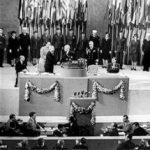San Francisco is the birthplace of an International Bill of Rights.
Here is where it was born: the War Memorial building on Van Ness Avenue in San Francisco.

After 50 million people were killed in WWII, many of them in gas chambers and other horrific ways, there was agreement that steps had to be taken to prevent athoritarian tyrants from gaining control over a nation, violating the rights of citizens, and waging war on their neighbors.
The creation of the United Nations was the first step in this direction, but it was understood that there needed to be a set of rights for people in all countries, and courts to enforce them in all countries, to truly prevent war.
To this end, at the War Memorial building in San Francisco, President Truman told the closing ceremony for the U.N. Charter in San Francisco “The first thing we will do is prepare an International Bill of Rights.”

President Truman then turned to Eleanor Roosevelt, and appointed her a delegate to the United Nations, where she became Chair of the newly created Human Rights Commission. The Commision’s goal was to implement this plan for an International Bill of Rights. and Eleanor, along with an international body, set out to draft an International Bill of Rights.
When asked what they were doing, they specifically said they were “drafting an International Bill of Rights”. As they worked, the Cold War stifled the vision of an enforceable International Bill of Rights, a true rights based approach that could prevent athoritarian governments from coming to power in any county, and provide for rights such as education and health care in all countries to provide for well-being for all.
Wisely, after a beautiful International Bill of Rights was written, rather than let the lack of enforcement kill the effort, Eleanor and others moved to an unenforceable declaration, the Universal Declaration of Human Rights. Even though they understood that the UDHR was unenforceable, they specifically inserted Article 28 into that Declaration stating the intent that future documents would be created that would make the rights in the UDHR enforceable in the courts of all countries.
This plan has partially worked. Following the UDHR, the European Convention on Human Rights was created in 1953, and with it a European Court of Human Rights emerged with judges from 47 countries enforcing the same Bill of Rights in all countries. If countries do not follow the decisions of the European Court, and make those decisions part of their domestic law, they can be fined, and if that does not work, they can be forced out of the Council of Europe, thereby losing valuable European trade privileges with 47 countries.
For many decades, the decisions of the European Court of Human Rights were almost uniformly followed by all 47 countries. Recently, with the invasion of Ukraine, and the statement of the Russian Government that its courts are not bound by the decisions of the European Court of Human Rights, the Court has been weakened, but it still remains as the best protection for human rights today, not the United Nations where almost all of the human rights machinery remains primarily reports and opinions that are not enforceable in courts of law.
Rene Cassin, who worked with Eleanor on the UDHR and was one of the first judges on the European Court, was awarded the Nobel Peace prize in 1968 for his work drafting the UDHR and his service as the President Judge of the European Court of Human Rights. With respect to the European Court, Judge Cassin told the Nobel Committee two simple words “It works.”

And Regional Courts do work. The Inter-American Court on Human Rights has been slowly advancing, as has the African Court on Human and People’s Rights, but these courts are not yet sufficiently developed to enforce an International Bill of Rights. Truman’s call for an International Bill of Rights has yet to be answered.
Why is this? It’s not because humans are just athoritarian by nature, like apes, which rely on hiearchy. Humans can read and write; that makes us unique among all species on Earth. Through reading and writing we can tell stories; the stories we tell create the lives that we lead. The story of an International Bill of Rights, with courts to enforce it, is worth retelling.

Today, the story of an International Bill of Rights, born in San Francisco, has gone fallow. It not just because of the athoritarian elements within the United Nations, of which there are many and their numbers are growing, it is also because the human rights community has become complacent and myopic, thinking that blaming and shaming is enough and not pushing for law. Almost all of the work at the UN on human rights consists of declaratons and reports. The Universal Periodic Review is a good example of discussion, but not law.
Einstein said “The problems of the world do not exist because of the evil people, but because of the good people who do nothing about them.” This profound insight is precisely where humanity finds itself today.
The celebration of the 75th anniversary of the Universal Declaration of Human Rights in 2023 is a good example. Hundreds of NGOs gathered to proclaim human rights as if saying rights repeatedly somehow makes them become law. (Jus cogens rarely works). None of them called for the expansion of Regional Courts and a renewed commitment toward an International Bill of Rights.
The same is true for the recent “Summit for the Future” held by the United Nations in September, 2024. It began with lofty goals to “renew our social contract”, but the outcome document, the “Pact for the Future”, did not even mention the strengthening and expansion of the Regional Courts.
It is going to take an international movement uniting people, nonprofits, businesses and governments to nuture the post World War II intent for an International Bill of Rights. If we fail to create such a movement, World War III is a genuine possibilty, and few of us, our children, or grand-children are likely to survive it. We don’t have to give birth to a new movement, that happened in San Francisco. Humanity is like an adolesent that has great potential, but is still in a tumultous part of life, with Unite we can help humanity mature into a young adult.
To this end, there are three specific things you can do to help. 1) join the Unite “Lights for Rights” campaign by signing your name and country on the website to show support for an International Bill of Rights; 2) share you thoughts on the Unite website about what rights you think should be included in an International Bill of Rights; 3) contribute funding to help Unite outreach to people, nonprofits, businesses and governments so that they can help you do numbers (1) and (2).
And if you are wondering whether we can succeed nuturing what was born in San Francisco, recall the words of Eleanor Roosevelt when she was asked about her work on an International Bill of Rights. “The future belongs to those who believe in the beauty of their dreams.”


Leave a Reply